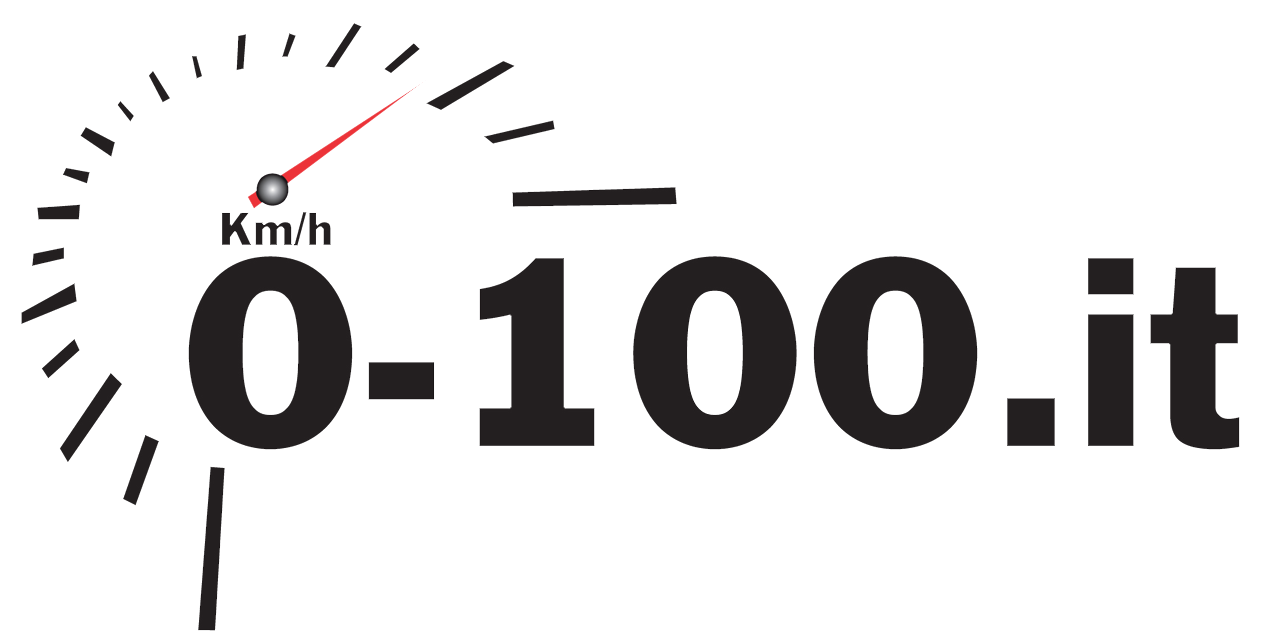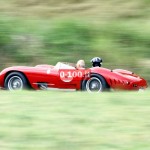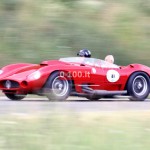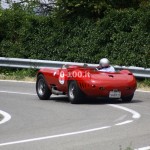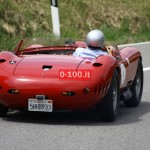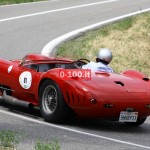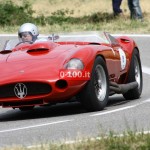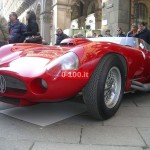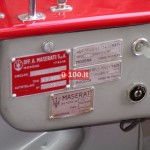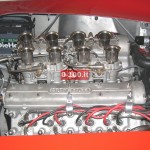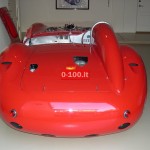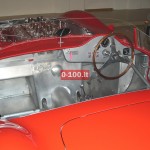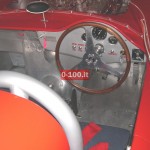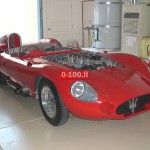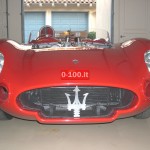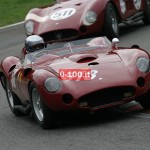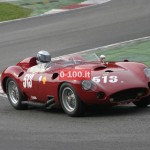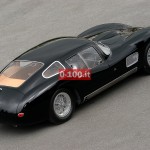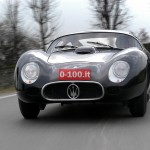Maserati 450 Sport 1957
Il progetto siglato “Tipo 54” naque nel 1954, ma fu ostacolato da un lungo letargo dovuto a molteplici fattori: programmi aziendali più importanti, un clima di incertezza dopo i terribili fatti della 24 Ore di Le Mans del ’55, la mancanza di un modello che fungesse da ispirazione, la complessità stessa della materia. Lo staff tecnico guidato dall’Ingegner Giulio Alfieri si organizzò così: all’ ing. Taddeucci il motore, telaio e trasmissione a Valerio Colotti.
MOTORE
La progettazione risultò certamente molto complessa per il primo, impegnato nella progettazione di un complesso 8 cilindri a V di 90° con distribuzione bialbero a camme in testa. Va tuttavia osservato che l’esperienza con i 4 cilindri 150S e 200S fu molto d’aiuto.Taddeucci riprese il disegno della testata e, più in particolare, della distribuzione. Esigenze di praticità e ingombri, consigliarono di posizionare i carburatori all’interno della V. Due magneti posizionati sul fronte del motore, sotto gli alberi a camme di aspirazione, assicuravano il funzionamento delle sedici candele disposte lungo l’asse mediano delle camere di scoppio. Il compatto monoblocco in lega leggera con camicie in ghisa piantate a caldo, portava sui fianchi, dinamo, motorino d’avviamento, e filtro dell’olio, mentre all’interno trovavano posto i cinque supporti di banco. Un complesso di due pompe, una di mandata e una di recupero, collocata nella parte anteriore, assicurava la corretta lubrificazione con un capace serbatoio da 20 litri che si trovava in coda a fianco di quello del carburante. Con un consumo ipotizzato di circa 1 litro ogni 500 metri fu studiato un serbatoio da circa 140 litri, con due supplementari ai lati del cambio. L’alimentazione avveniva mediante tre pompe elettriche in parallelo. Il raffreddamento ad acqua era assicurato da due pompe centrifughe a circolazione separata per le due teste, comandate dai soliti ingranaggi della distribuzione.
TRASMISSIONE
Non meno complessa fu la trasmissione: si trattava di trasmettere a terra 400 Cv, una potenza esorbitante all’epoca. Colotti disegnò una trasmissione particolarmente robusta: il cambio era a cinque marce sincronizzati in blocco con il differenziale (tipico schema Transaxle). Quest’ultimo era del tipo autobloccante ZF portato in posizione longitudinale dentro il passo per non sovracaricare il retrotreno. La frizione di notevoli dimensioni era composta da quattro anelli d’acciaio, e cinque di alluminio. In uscita, una coppia di ingranaggi cilindrici, consentiva una rapida intercambiabilità dei rapporti. Il telaio derivava strettamente da quello della Maserati 300S: alla base tubi ovali di grossa sezione integrata da una struttura superiore a tubi circolari. Lo stesso criterio era adottato per le sospensioni anteriori, mentre il retrotreno, sempre con ponte De Dion, era stato ridisegnato: il tubo di collegamento passava dietro il differenziale, secondo lo schema già utilizzato sulla 350S. Del tutto nuovo era invece l’impianto frenante con grossi tamburi da 400 mm davanti e 350 mm dietro.
I PRIMI RISULTATI IN GARA
Il primo motore 450S fu pronto nella primavera del ’56 e montato sul telaio n°3501 corrispondente alla 350S e rinumerato 4501. Dopo un breve collaudo, la 4501 partecipò al Gran Premio di Svezia del 7 agosto. Visivamente si distingueva dalle 300S per la grande gobba sul cofano anteriore e per i 4 tubi di scarico che affioravano sulle fiancate. Da quella prima esperienza si ricavò grande soddisfazione per il potenziale della 450S. Tuttavia il motore generava notevoli vibrazioni che si trasmettevano a tutta la trasmissione. Problema, questo, risolto con la semplice revisione dell’ordine di accensione.
Il debutto al Campionato Mondiale Marche 1957 avvenne a Buenos Aires con la 4501 totalmente ricostruita: nuovo telaio, nuova carrozzeria (aderente al regolamento internazionale con parabrezza integrale e più aerodinamica). Grazie alla maggiore inclinazione dei carburatori, la gibbosità del cofano era appena percettibile, mentre erano cresciuti gli scarichi raggruppati in un unico tubo finale per lato. La 450S dimostrò tutto il suo potenziale ma non riuscì a ottenere la vittoria. Questa arrivò alla 12 Ore di Sebring con la 450S telaio 4503 di Fangio/Behra.
Nel frattempo lo sviluppo continuò incessante: dalla 450S telaio 4504 fu dotato di un sistema di accensione mista o con due spinterogeni, doppi ammortizzatori (gli Houdaille tendevano a rompere gli attacchi delle leve), nuovi serbatoi del lubrificante e altre modifiche di minor conto. In vista della Mille Miglia del 1957 la 450S telaio 4505 di Moss fu equipaggiata con un cambio supplementare a due velocità posto tra motore e trasmissione. In pratica un overdrive che permetteva di abbassare il regime di rotazione del motore. Visti i buoni risultati fu montato anche sui telaio 4507, 4508 e alla 4501 che avrebbe partecipato alla 24 Ore di Le Mans di giugno ’57.
La 24 Ore di Le Mans era un obbiettivo prioritario per la Maserati. Eppure fu un fiasco malgrado la rilevante novità di una 450S versione Coupé aerodinamica. La 450S Coupé era stata richiesta da Stirling Moss, che suggerì probabilmente di affidare il progetto a Frank Costin. La produzione della carrozzeria sul telaio 4501 fu affidato a Zagato, che la portò a termine in pochi giorni. Tuttavia, a causa di scarsi test probatori, la macchina palesò da subito gravi problemi: in gara si produceva un eccessivo surriscaldamento al motore e, di conseguenza, al pilota. Il calvario di Moss fu comunque breve: la 450S Coupé fu costretta al ritiro a causa di un cedimento meccanico.
Riportata alla Maserati, la Costin Coupé rimase dimenticata per circa un anno e nel 1958 fu riesumata da un cliente americano in visita all’azienda. Byron Staver si innamorò della Coupé e la volle come vettura stradale. I tecnici la rinumerarono come telaio 4512 dotandola di finiture comfort e rivestimenti.
LA 450S TENTA IL TUTTO E PER TUTTO
Gli inattesi risultati dell’Aston Martin alla gara del Nurburgring e della Jaguar alla 24 Ore di Le Mans, avevano fiaccato il potenziale della Ferrari e mantenuto apert la lotta per il titolo mondiale, saldamente alla portata della Maserati. Purtroppo, però, al Gran Premio del Venezuela, ultima gara del campionato, tutte le Maserati schierate alla partenza (due 450S e una 300S) dovettero ritirarsi. Ferrari prima assoluta, Maserati seconda, il miglior risultato al Mondiale Marche di sempre.
L’AVVENTURA AMERICANA
Più che dagli ingenti danni materiali sofferti nella disastrosa trasferta sudamericana, la Maserati fu colpita dai regolamenti, che, nel 1958 ammettevano alle prove mondiali solo vetture 3 litri. Cio nonostante e malgrado il ritiro della casa dalle corse, la 450S fece parlare doi se’ negli USA dove non esistevano limiti di cilindrata. Fina dal 1957, le 8 cilindri Maserati avevano dettato legge con Masten Gregory, Carrol Shelby, Eb Rose, Jim Hall, Walt Cline. Tanto successo era opera di mecenati come Tony Parravano, Temple Buell, Briggs Cunningham.
LA 450S IN VERSIONE “MARINA”
Nel 1959 cominciò la l’era della 450S in versione marina, ugualmente travolgente come lo era stata quella piu’ breve in campo automobilistico. La prima unità ad essere sviluppata, fu il “Tipo 59” di 5665 cc. (103 x 85 mm.) che forniva 520 cv @ 7000 giri al minuto. Nel 1962, furono preparate tre nuove versioni: il “Tipo 201” di 5400 cc. (103 x 81 mm.) con 420 cv, il tipo 62 di ben 6462 cc. (110 x 85) sviluppante l’enorme potenza di 580 Cv e il “Tipo 202″ di 4.941 cc. (94 x 89 cc.) con 330 cv. Con scafi mossi da questi formidabili motori, numerosi piloti italiani, da Lino Spagnoli, a Flavio, Liborio e Giorgio Guidotti, a Nando dell’Orto, Ermanno Machisio, Luigi Crivelli, conquistarono, negli anni ’60, innumerevoli titoli europei e mondiali.
[vc_tta_tabs active_section=”1″ title=”Scheda Prodotto”]
[tab title=”NUMERI DI TELAIO”]
| TELAIO | MOTORE | NOTE | PROPRIETARIO ATTUALE |
| 3501/4501 | 4501 | Agosto 1956: prototipo creato dalla 350S n. 3501. 1987: restauro completo. Monta il motore 4519 | Lombardi (I) |
| 4502 | 4502 | Ottobre 1956: Tony Parravano 1957: Ray Martinez per Billy Krause 1989: Von Donhoff (Bad Tolz, Germania) Fine Anni 90: Hartmut Ibing (D) | Albert Spiess (CH) |
| 4503 | 4503 | Vettura ufficiale 1956: 12 Ore di Sebring (Fangio/Behra): 1° posto ass. Novembre 1957: Caracas, GP di Venezuela: distrutta. Ricostruita e venduta in Brasile 1994: Casoli (I) | – |
| 4504 | 4504 | Maggio 1957: Jim Kimberly (USA) 1958: Don Perkins (?) | – |
| 4505 | 4505 | Maggio 1957: Mille Miglia (n.537, Moss – Jenkinson): ritiro per avaria. 1957: Scuderia Temple Buell 1958: Jim Hall 1958: John Edgar per Carroll Shelby | – |
| 4506 | 4506 | 1957: John Edgar per Dan Gurney 1958: Jim Rathmann 1959: Chuck Daigh 1984: Collezione Rosso Bianco (Aschaffenburg, D). 2003: Thomas Bscher (D) | Bscher (D) |
| 4507 | 4507 | Agosto 1957: GP di Svezia (Behra – Moss): ritiro per avaria Novembre 1957: Caracas, GP di Venezuela: distrutta. | – |
| 4508 | 4508 – 4511 | Marzo 1957: Scuderia Temple Buell. Novembre 1957: Caracas, GP di Venezuela: distrutta. Ricostruita e venduta in America. 1958: monta il motore marino n.4511 da 5.7 litri. 1959: Jim Hall, USA Anni 80: Nick Soprano (vista alla Mille Miglia 1984, 1986 e ’87) | – |
| 4509 | – | Gennaio 1958: Carroll Shelby Cars per EB Rose 195?: monta un motore Chevrolet 5.7 1987: Hayashi (J) | – |
| 4510 | Gennaio 1958: Carroll Shelby Cars 1958: Frank Harrison 1961: monta il motore 4514 Anni 80: Bruce Vanyo (USA) Anni 90: Tom Hollfelder (USA) | Hollfelder (USA) | |
| – | 4511 | 1961: motore installato sul telaio 4510 | – |
| 4512 | 1957: ex 4501 con carrozzeria coupé Zagato per la 24 Ore di Le Mans (Moss – Schell): ritiro per avaria. 1958: ricostruita come coupé stradale per Byron Staver e rinumerata 4512. Anni ’80: Collezione Rosso-Bianco (Aschaffenburg) | Walton (USA) | |
| ? | 345 | Motore installato nel telaio 4503 (?) | – |
| 4515 | Marzo 1959: Motore marino Tipo 59 per Lino Spagnoli | ||
| 4516 | Marzo 1959: Motore marino Tipo 59 per Guidotti | ||
| 4524 | Dicembre 1961: Motore marino Tipo 59 | ||
| 4525 | Dicembre 1961: Motore marino Tipo 59 per Briggs Cunningham (USA) | ||
| 4527 | Aprile 1962: Motore marino Tipo 59 | ||
| 4528 | Aprile 1963: Motore marino Tipo 62 per Luigi Crivelli |
[/vc_tta_section]
[vc_tta_section title=”Dati tecnici” tab_id=”1aTBnwOposta”]
| MOTORE | |
| Motore | Anteriore, centrale, longitudinale, 8 cilindri a V di 90° |
| Cilindrata | 4.477 cc |
| Alimentazione | aspirazione libera mediante quattro carburatori doppio corpo Weber IDM |
| Accensione | Doppia, magneti o spinterogeni Marelli |
| Distribuzione | bialbero a camme in testa, 2 valvole per cilindro |
| Potenza | 400 Cv a 7.200 giri |
| Coppia | 488 Nm a 5.500 giri |
| TELAIO | |
| Telaio | Traliccio tubolare in acciaio, carrozzeria in alluminio |
| Sospensioni | anteriori a ruote indipendenti, ammortizzatori idraulici Houdaille (in seguito, doppi ammortizzatori); posteriori a ponte posteriore De Dion, ammortizzatori idraulici Houdaille (in seguito, doppi ammortizzatori) |
| Sterzo | a cremagliera |
| Freni | 4 tamburi |
| TRASMISSIONE | |
| Trazione | posteriore |
| Cambio | 4 marce + RM |
| DIMENSIONI E PESI | |
| Peso | circa 800 kg. |
| PRESTAZIONI | |
| Velocità max. | oltre 320 km/h |
| PREZZI | |
| Produzione | 11 esemplari tra il 1956 e il 1958 |
[/vc_tta_section]
[vc_tta_section title=”Album fotografico” tab_id=”1aTBnwOpost”]
[/vc_tta_section]
[/vc_tta_tabs][:en]The “Type 54” project was born in 1954, but was hampered by a long hibernation due to several factors: more important business programs, a climate of uncertainty after the terrible events of the 24 Hours of Le Mans in ’55, the lack of a model which could serve as inspiration, the complexity itself of the matter. The technical staff led by Engineer Giulio Alfieri was organized as follows: the engine to eng. Taddeucci, chassis and transmission to Valerio Colotti.
ENGINE
The design certainly turned out very complex for the first one, engaged in the design of a V complex 8-cylinder 90° with double overhead camshafts in the head. It should be noted, however, that the experience with the 4-cylinder 150S and 200S was very helpful. Taddeucci recalled the head design and, more particularly, the distribution. Requirements of practicality and dimensions suggested to place the carburettors inside the V. Two magnets positioned on the front of the engine, under the intake camshaft, assured the functioning of the sixteen candles arranged along the median axis of the combustion chambers. The light alloy compact monoblock with cast iron liners hot mounted, showed on its sides generator, starter, and oil filter, and inside it was located the five main bearings. A complex of two pumps, one for delivery and another for recovery, placed in the front, ensured the correct lubrication with a capable 20 litre tank which was in the tail near that of the fuel. With a consumption estimated in about 1 litre every 500 meters, it was studied a tank of about 140 litres, with two additional at the side of the gearbox. The power source was given by using three electric pumps in parallel. The water cooling was provided by two centrifugal pumps in separate circulation for the two heads, controlled by the usual timing gears.
TRANSMISSION
The transmission was also hard: it was 400 hp, an exorbitant power at the time. Colotti designed a particularly strong transmission: there was a five-speed gearbox synchronized with the differential (typical Transaxle model). The latter was the ZF self-locking type allocated in longitudinal position inside the pitch not to overload the rear axle. The large clutch was composed of four steel and five aluminum rings. In output, a pair of spur gears allowed a rapid interchangeability of ratio. The chassis was strictly derived from that of Maserati 300S: oval tubes with big section formed the base, and it was integrated with an upper structure formed by circular tubes. The same scheme was adopted for front suspension, whereas the rear axle with De Dion tube was drawn again: the tube passed behind the differential, according to the scheme already used on the 350S. The braking system with big drums 400 mm front and 350 mm rear was instead entirely new.
THE FIRST RESULTS OF THE RACE
The first 450S engine was ready in the spring of ’56 and mounted on the chassis no. 3501 corresponding to the 350S and renumbered 4501. After a quick test, the 4501 participated in the Swedish Grand Prix on August 7. Aesthetically, it differed from the 300S for the large hump on the bonnet and for the 4 exhaust pipes which cropped up on the sides. Since that first experience it was obtained great satisfaction for the 450S potential. However, the engine generated considerable vibrations which were transmitted to the entire transmission. A problem solved thanks to a simple review of the ignition system. The debut at the World Sports Car Championship 1957 took place in Buenos Aires with a completely rebuilt 4501: new chassis, new bodywork (adhering to international regulations with integral windscreen and more aerodynamic). Due to the increased inclination of the carburettors, the protrusion of the bonnet was barely visible, while the exhaust system grouped into a single pipe for each side had increased. The 450S showed all its potential but failed to get the win. The latter came at the 12 Hours of Sebring thanks to the 450S chassis 4503 Fangio/Behra. Meanwhile, it continued to be developed unrelentingly: from the 450S chassis 4504 was equipped with a mixed ignition system or with two coils, two shock absorbers (the Houdaille tended to break the levers attacks), new oil tanks and other minor changes. In view of the Mille Miglia in 1957, the 450S chassis 4505 by Moss was equipped with a two-speeds extra gearshift placed between engine and transmission. Practically, an overdrive which was used to lower the rpm of the engine. Given the good results, it was also mounted on the chassis 4507, 4508 and 4501 which would have participated in the 24 Hours of Le Mans in June ’57. The 24 Hours of Le Mans was a priority objective for Maserati. Yet it was a failure despite the significant change of a 450S version Coupé aerodynamic. The 450S Coupé was requested by Stirling Moss who probably suggested to entrust the project to Frank Costin. The production of the bodywork on the chassis 4501 was entrusted to Zagato, who completed it in a few days. However, because of poor test evidence, the car showed immediately serious problems: during the race it produced an excessive overheating to the engine and, consequently, to the pilot. The ordeal for Moss, however, was short: the 450S Coupé was forced to retire due to a mechanical failure. Brought back to Maserati, the Costin Coupé was lost for about a year and in 1958 it was revived by an American customer visiting the company. Byron Staver fell in love with the Coupé and wanted it to be a road car. The technicians renumbered it as 4512 chassis, providing it with comfort finishes and coatings.
THE 450S TRIES ANYTHING ONCE
The unexpected of Aston Martin at the Nurburgring race and of Jaguar at the 24 Hours of Le Mans had weakened the potential of Ferrari and kept open the fight for the world title, firmly within the reach of Maserati. Unfortunately, however, at the Venezuela Grand Prix, the last race of the season, all Maserati (Two 450S and a 300S) lined up for the start had to withdraw. Ferrari first, Maserati second, the best result in the World Sports car Championship ever.
AMERICAN ADVENTURE
Maserati was struck by the regulations which, in 1958, admitted to the world’s tests only 3-litre cars, rather than by substantial material damage suffered during the disastrous trip in South America. Nevertheless, and despite the withdrawal of the company from racing, the 450S made itself heard in the USA where there were no limits of engine size. Since 1957, the 8-cylinder Maserati had laid down the law with Masten Gregory, Carrol Shelby, Eb Rose, Jim Hall, Walt Cline. All that success was due to patrons like Tony Parravano, Temple Buell, Briggs Cunningham.
THE 450S “MARINA” VERSION
In 1959 it was started the era of 450S marine version, also overwhelming as it had been the shorter one in the automotive field. The first unit to be developed was the “Type 59” 5665 cc. (103 x 85 mm.) which provided 520 hp, 7000 rpm. In 1962, three new versions were prepared: the “Type 201” 5400 cc. (103 x 81 mm.) with 420 hp, the type 62 even 6462 cc. (110 x 85) developing the enormous power of 580 hp and the “Type 202” 4,941 cc. (94 x 89 cc.) with 330 hp. With hulls moved by those formidable engines, many Italian pilots, from Lino Spagnoli, to Flavio, Liborio and Giorgio Guidotti, to Nando Orto, Ermanno Machisio, Luigi Crivelli conquered, in the 60’s, many European and world titles.
[/vc_tta_section]
[/vc_tta_tabs]
